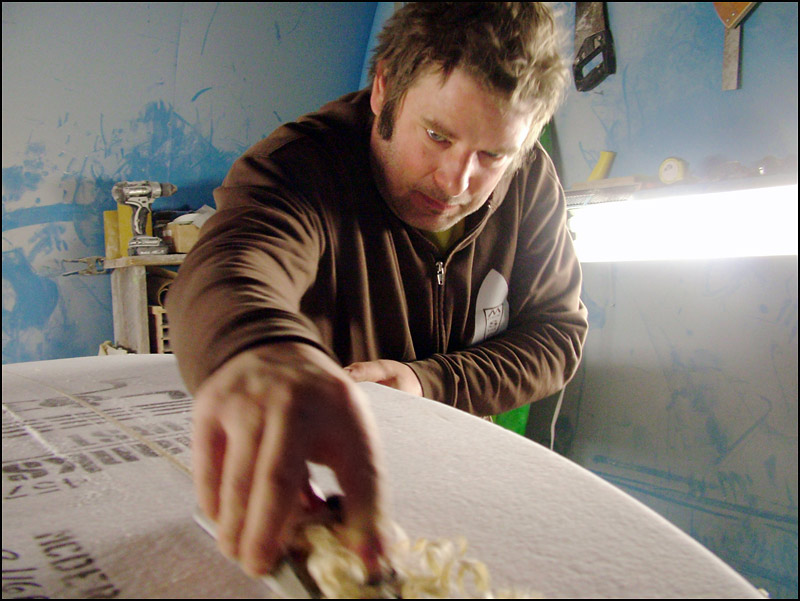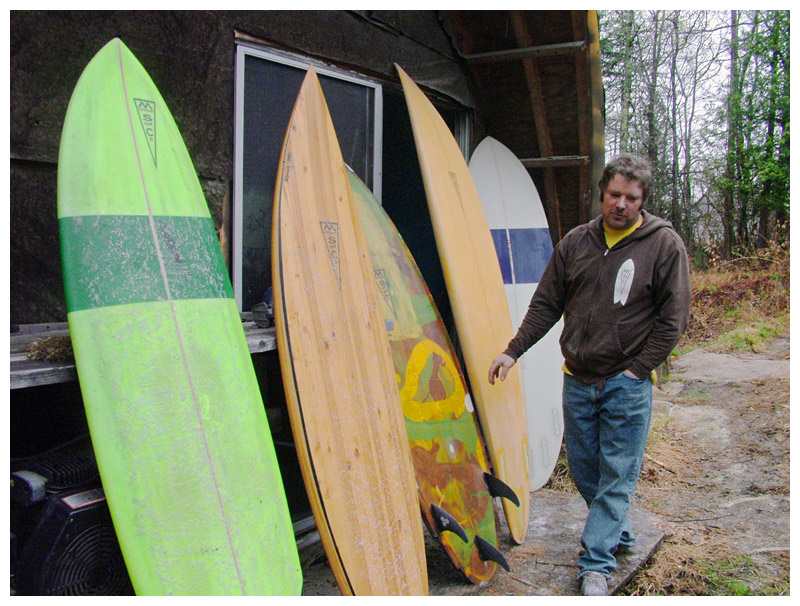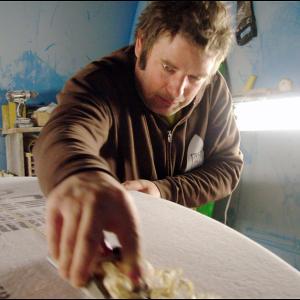Monroe surfboard maker finds perspective in a state not known for the sport
 Monroe Surf Co. owner Josh Moody shaves the wooden “stringer” support embedded in the foam “blank” that will eventually become a custom-designed surfboard. For this photo, Moody removed the respirator that he normally wears in the shop. (Photo by Ethan Andrews)
Monroe Surf Co. owner Josh Moody shaves the wooden “stringer” support embedded in the foam “blank” that will eventually become a custom-designed surfboard. For this photo, Moody removed the respirator that he normally wears in the shop. (Photo by Ethan Andrews)
 Josh Moody outside of his surfboard workshop, located next to his home in Monroe. (Photo by Ethan Andrews)
Josh Moody outside of his surfboard workshop, located next to his home in Monroe. (Photo by Ethan Andrews)
 Monroe Surf Co. owner Josh Moody shaves the wooden “stringer” support embedded in the foam “blank” that will eventually become a custom-designed surfboard. For this photo, Moody removed the respirator that he normally wears in the shop. (Photo by Ethan Andrews)
Monroe Surf Co. owner Josh Moody shaves the wooden “stringer” support embedded in the foam “blank” that will eventually become a custom-designed surfboard. For this photo, Moody removed the respirator that he normally wears in the shop. (Photo by Ethan Andrews)
 Josh Moody outside of his surfboard workshop, located next to his home in Monroe. (Photo by Ethan Andrews)
Josh Moody outside of his surfboard workshop, located next to his home in Monroe. (Photo by Ethan Andrews)
MONROE - When he was in college, Josh Moody went with a friend to a skateboard shop in southern Maine. In the back of the store, there were a handful of surfboards. Moody thought it was joke.
Some years later, after he’d caught the bug for surfing in far-flung locales known for big waves, his skating buddy from college divulged that he’d been surfing in Maine all along.
“And you didn’t tell me?” Moody said.
He recreated the scene while walking up his driveway from the workshop where he builds surfboards today as the owner operator of Monroe Surf Company.
The thought of surfing in Maine is probably only surprising to nonsurfers. Likewise, despite being located 20 miles inland from the closest reach of Penobscot Bay and a two hour drive from the state’s best breaks, Moody’s business is known to local surfers. Enough so, that aside from a dry spell last winter when he worked for a local boatbuilder, Moody said he has been able to make a living for the last three years entirely from his surfboards.
The whole thing started after a trip to Costa Rica in 2009 where Moody rented a cabana from a man with fleet of surfboards. Over a period of two months, he tried 70-or-so different boards. “I realized none of them fit me,” he said. “There were parts of them, aspects that I liked.”
But none of them had what he called “the magic equation.” So, when he returned to Maine, he built one.
“I went from being a one or two wave per session guy to 10,” he said, referring to the number of successful rides in an outing. “It made surfing more fun.”
The magic equation turned out to be more than a matter of taste. Moody built a board for a friend, adjusting his initial design for differences in height, weight and skill level. The friend’s improvement was as significant as Moody’s had been.
“I thought, ‘OK, maybe this is valid. Maybe I’m good at this,’” he said.
Customized boards are typical on the pro circuit where equipment is constantly being tweaked for ideal performance. But Moody’s goal was more democratic.
“A lot of guys think about it as all about performance,” he said. “I think about it as: it’s all about fun. I want people to catch more waves.”
Moody described the perfect Maine surfing conditions as 4-6 foot waves, 11-16 seconds apart with a steady 5-10 knot northwest wind. Conditions, of course, are rarely perfect — serviceable two foot swells are often enough to get Maine’s wetsuit-wearing riders into the water— but they tend to be better at the sandy beaches of southern Maine because of relatively even pitch of the seafloor. Moody was quick to note that he’s surfed as nearby as Searsport. During Tropical Storm Irene, he rode waves near the boathouse in Belfast Harbor.
Since 2009, Moody has built 126 boards, selling them by word of mouth referrals, through his website and in stores. His goal is to make 1,000 by his 40th birthday, three years from now (“It’s a lofty goal,” he said), and then keep making them for as long as he can after that.
Brick-and-mortar surf and bike shops have bumped his sales way up, he said. The stock models he supplies to stores cost the same as customized boards, but the custom boards require two weeks lead time, and many people just don’t want to wait.
Moody would rather they did, but on the bright side he speculated that today’s impulse buyer could be tomorrow’s custom-shop customer.
“As they learn through surfing, patience is the key,” he said.
Like anyone handcrafting a product that is also mass-produced, Moody has to compete cheap imports. “Pop out” boards, typically from China, sell for a fraction of Monroe Surf Co. prices ($550 and up, according to the length of the board). Moody said the Chinese boards don’t last nearly as long or perform as well, but people don’t necessarily take the long view.
The same could be said of the materials used to make boards, which, for all the zen trappings of surf culture, are essentially hostile.
Outside the door of the small A-frame where Moody shapes his boards, polyurethane fumes hang in the air. Inside there’s dust of the same, residue from the slow process of shaping the foam “blank” with rasps and planes to the desired shape and size. Moody wears a respirator and asks guests to do the same. A separate shed used for a resin coating process called “glassing” is toxic enough that he leaves it out of the tour altogether.
About 40 of the Monroe Surf Co. boards have included some eco-friendly materials, but there’s only so much that a small company can control. Most critically, the foam blanks that serve as the core of the surfboard are made by a handful of large suppliers, and aren’t easily replicated on a small scale.
Several companies have made replacements, and Moody has kept a close eye on new innovations. The less toxic blanks available to date don’t perform as well as their polyurethane counterparts. And in a market that hinges on what the professional riders are using, that’s a deal breaker.
“[Amateurs] see the pro out there on the 4-ounce board,” and that’s what they want, Moody said. “It’s light, it’s performance oriented and it’s super toxic.”
Going green would be a gamble for the industry, he said. “But the reality is that we all need to move on this, and the pros are going to need to do that, too.”
For as many market forces are working against him, Moody said he’s benefitted from the strong buy-local ethos in Maine. Setting up shop in the woods of Monroe has also meant lower overhead, which has allowed him to keep his prices competitive.
“If feel like I wouldn’t be able to do what I’m doing if I didn’t live here,” he said.
For more info: Monroe Surf Co.
Ethan Andrews can be reached at news@penbaypilot.com
Event Date
Address
United States





























